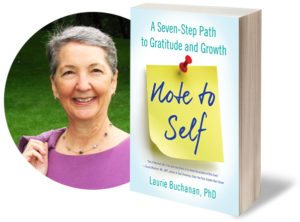By Laurie Buchanan, PhD
“Life is about showing up, so is writing. That’s why I sit at my desk every day and dance my fingers across the keyboard.” —Laurie Buchanan
For me, the foremost similarity between writing magazine articles and writing a book is my muse. Different for each person, a muse is the source of inspiration for a creative work. My muse is empty space and silence. My writing area is an 8×12 foot room that has five, four-foot tall windows overlooking a beautifully landscaped area. The small glassed-in room is home to a loft-size desk, an ergonomic “kneeling” chair, and a tea light candle holder. Before I sit down to write, I light the candle. The flame is my “contract” to write until the it goes out on its own (4-6 hours depending on the brand of the candle). And I have blatantly stolen author Anne Lamott’s prayer: “Please help me get out of the way so I can write what wants to be written.” The care and feeding of my muse involves keeping the windows sparkling clean, the room free of debris, and insuring silence. Hence, three-flange earplugs can always be found in my desk drawer. Other similarities between writing magazine articles and writing a book are my writing style: word economy, brevity, concision. And my frame of mind: confidence and persistence.
One of the differences for me is voice. With articles, a writer has significantly smaller word count—less time—so I “shoot from the hip,” often using bullet points for clarity and making succinct statements. If you’re a dog lover, think West Highland White Terrier—quick little yips that get straight to the point.
By comparison, the reader has much more time with a book so I take time to cultivate information that helps readers draw their own conclusions. One of the ways to accomplish this is through the use of what I call “internal inventory” questions; questions designed to draw readers inward for an up close and personal examination. Using the dog analogy, this voice is that of a Basset Hound. Slow and methodical, they get the job done.
John Gardner wrote, “The writer is creating a dream into which he or she invites the reader, and that the dream must be vivid and continuous.” Regardless—magazine article or book—it’s my job to engage the reader and keep it moving forward.
Another difference is that for articles—and weekly blog posts—I usually work with a supporting photograph. Again, the verbiage can be shorter because the “picture paints a thousand words.” Typically, that’s not true with a book.
No matter the venue, I treat my readers the same as I would if they were sitting in my office—with respect. That brings to mind two occasions when my expertise as a holistic health practitioner was called upon by two different magazines. One wanted an article titled “Have Sex for Better Health,” and the other wanted an article titled “The Art of Conception.” Both articles were straightforward, while at the same time honored my readers’ modesty.
For me—I’m sure it’s different for other writers—two more similarities between writing magazine articles and writing a book are rewrites and spinning platters.
Rewrites—I’ve never had a first draft (or many second drafts, and sometimes thirds ) that are “keepers.” Everything gets reworked.
Spinning Platters—I always have multiple projects going simultaneously. At this moment I have five nonfiction articles, a collection of short stories, a nonfiction book, and a fiction book. If I find myself banging my head against the wall while working on one, I simply shift gears and switch to another.
The question I’m asked most often when speaking and presenting workshops at writing conferences is, “What’s the most important advice you can give an aspiring writer?” My answer is always the same: self-confidence, persistence, and concision. I’ve found these three ingredients to be unbeatable!
“Writers are the wind that sail words across the page.” —Laurie Buchanan

LAURIE BUCHANAN, Ph.D., is a holistic health practitioner, transformational life coach and author of Note to Self: A Seven-Step Path to Gratitude and Growth (She Writes Press; November 1, 2016).

